
Для просмотра автоматического перевода на русский язык нажмите ЗДЕСЬ
Источник: https://aras.org/special-feature
ARAS and the Art and Psyche Working Group, in collaboration, have developed a new project, “Art in a Time of Global Crisis: Interconnection and Companionship,” as an international outreach through art. Our goal is to create a network of mutual support through art during this difficult time.
Colleagues and friends from around the world, representing various cultures, geographical locations and life-styles, have been invited to contribute artistic images with commentaries that represent companionship, resilience and hope in the face of threat, fear and struggle.
We plan to post one new offering each day (Monday-Friday) in our curated “virtual gallery.” With a consistent presence of art that expands with each new contribution, we hope to weave a web of interconnectedness during this current time of global upheaval. On this page you will find daily postings that will accrue and form an ever-growing collection that embraces art and soul.
For a more detailed introduction to this project and how it will operate, please CLICK HERE
Daily Image and Commentary #1, April 13, 2020

Giovanni Battista Tiepolo (c. 1749), Ceiling Fresco, An Angel Saving a Falling Craftsman from Collapsing Scaffolding, Sala Capitolare Hall, Scuola Grande dei, Carmini, Venice
During moments of fear and anxiety, I bring forward this image that I first saw in Venice many years ago. It helps me to remember that there are often unexpected, even surprising and miraculous helpers who come forward from the outer world and from within. Often, strong aspects of myself that I had forgotten about but who have not forgotten me emerge at such times. Even just the memory of this painting and the day in Venice when I first encountered it, eases the suffering.
Linda Carter
Carpinteria, CA
Email: lindacarter5066@gmail.com
Daily Image and Commentary #2, April 14, 2020

Wreath by Ami Ronnberg, Collage on fabric, 1991, New York.
Initially, it was the picture of outstretched arms in a generous gesture of offering fruit (on left side) that sparked my imagination and inspired me to create this wreath. I then added images of light and darkness – an angel providing sheltering protection, the stars reminding me that the night is never completely dark, the apple blossoms promising spring. Even the deepest sorrow, as we see in the faces of Adam and Eve at the bottom of the wreath, may grow into insight and wisdom as the circle of life keeps turning.
Ami Ronnberg
New York, NY
Email: aras@aras.org
Daily Image and Commentary #3, April 15, 2020

Le sette opera della Misericordia, 1607 (The Seven Works of Mercy) By Michelangelo Merisi da Caravaggio, Pio Monte della Misericordia, Naples, Italy
In this painting by Caravaggio, it is the light coming from the compassionate Madonna and child along with the angels, that moves me as a reminder of the divine that dwells in us and can be expressed through the works of Mercy. Light springing from the wings of the angels is illuminating charitable efforts to alleviate the needs of the afflicted, as acts of love towards the brothers in suffering; there is no distinction of status. Looking at this painting, so carnal and, at the same time, so spiritual, makes me believe that there is always hope.
Caravaggio deeply understood what he was doing in creating this masterpiece; memories of his father and grandfather, who both died in the bubonic plague, when he was six years old, remained with him for all his life. He himself, as a young artist, poor and with no protection, nearly died of malaria and was saved in a lazaretto* that did take care of the poor.
*Lazaretto: An isolation hospital for people suffering infectious diseases (first one established in Venice, 1423). From the parable of St. Lazarus, a poor and ill beggar, aided by an unnamed rich man. (Luke 16:19-31)
Caterina Vezzoli
Milano, Italia
Daily Image and Commentary #4, April 16, 2020
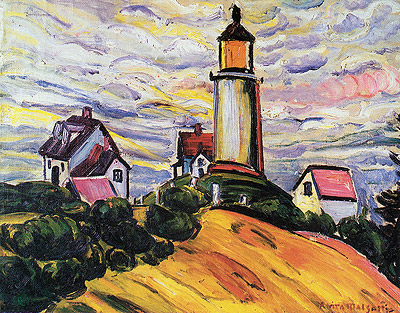
The Lighthouse, 1915 by Anita Malfatti, Brazilian Expressionist Painter, Modern Art Museum, Rio de Janeiro, Brazil
In times of darkness, the lighthouse stays up. This is a daytime image, inspiring us to cross chaos and fear sustained by solidarity and human spirit.
“As far as we can discern, the sole purpose of human existence is to kindle a light in the darkness of mere being” (Jung 1963. Memories, Dreams, Reflections, p. 326).
Symbols guide human action and for Jung symbol formation has an important biological function, as it allows us to detach from the object and not be absolutely determined by it. (Psychological Types, CW 6, para. 402)
Liliana Liviano Wahba
São Paulo, Brazil
Email: lilwah@uol.com.br
Daily Image and Commentary #5, April 17, 2020
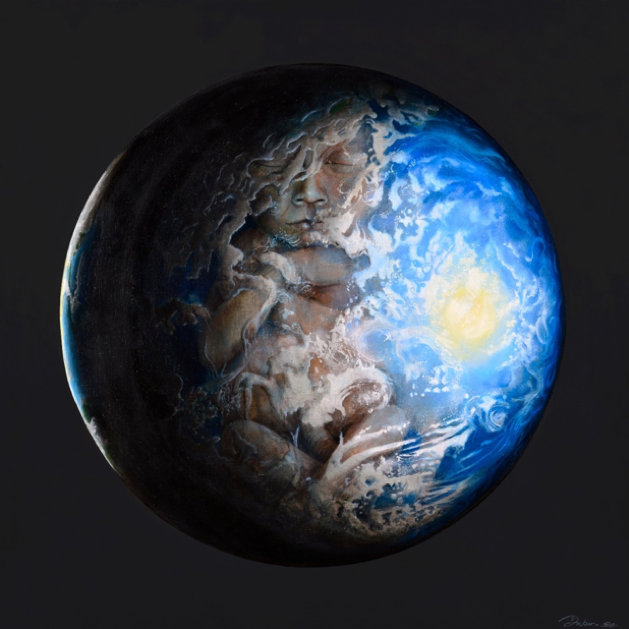
Mater 2 by Pia Imbar. Mixed media on canvas, 113 x 113 cm, 2011, artist’s possession
*Please see link below for an extraordinary experience related to this image
In these times, when anxiety, uncertainty, and insecurity are interspersed with hope and a profound questioning of our society’s values and ethics, I propose this painting by Pia Imbar (http://www.piaimbar.com/), which represents our pregnant Earth. To me, it is a powerful reminder of how important it is to take care of the world that we will eventually leave to our children, and it is my hope that the present crisis may also be pregnant with insights that may lead to solutions and decisions that are more respectful of life on this planet in all of its forms.
*To view “Piano and Painting,” a beautifully crafted 3 minute, stop motion video of Pia’s creating the stunning image above, accompanied by Catherine Schneider on piano, please visit https://youtu.be/fxu9xlz2evM
Ernst Falzeder
Salzburg, Austria
Email: falzeder@gmail.com
Daily Image and Commentary #6, April 20, 2020
Mill Valley Howl, April, 2020 by Peter Reynolds
Walt Whitman would be proud of the people of Mill Valley, California. Peter Reynolds, my neighbor and colleague, shows why in his video recording of the newly emerging ritual of communal howling that begins every evening at precisely 8 pm and that lasts for several minutes. To witness the howling, click on the image above.
The first words that came to mind when my wife and I joined in the boisterous cacophony with our fellow citizens was Whitman’s phrase “barbaric yawp.”
The spotted hawk swoops by and accuses me—
he complains of my gab and my loitering.
I too am not a bit tamed, I too am untranslatable,
I sound my barbaric yawp over the roofs of the world…
(Whitman 1855)
Whitman, considered by many to be the poet of America’s soul, would clearly recognize the barbaric yawp in the chorus of hoarse and high-pitched cries in response to the “shelter in home” status imposed on all of us by the coronavirus pandemic. Over the hills and into the valleys of Mill Valley, this yawping choir rings with an uproarious thunder of clanging and hooting that is infectiously joyous and liberating. Miraculously, a broad smile erupts on our faces, even in the midst of growing isolation and dread. The anonymous echoing and coming together of faceless voices in the night makes it all the more uncanny and powerful. That the sounds mimic the nightly howls of the local coyotes brings to mind further lines from Whitman’s Leaves of Grass…
*To read more of Tom’s reflections inspired by the neighborhood “howling” and Whitman’s Leaves of Grass, please see the full version at https://billmoyers.com/story/on-howling-in-mill-valley-and-walt-whitmans-barbaric-yawp/
Thomas Singer
Mill Valley, California
Daily Image and Commentary #7, April 21, 2020
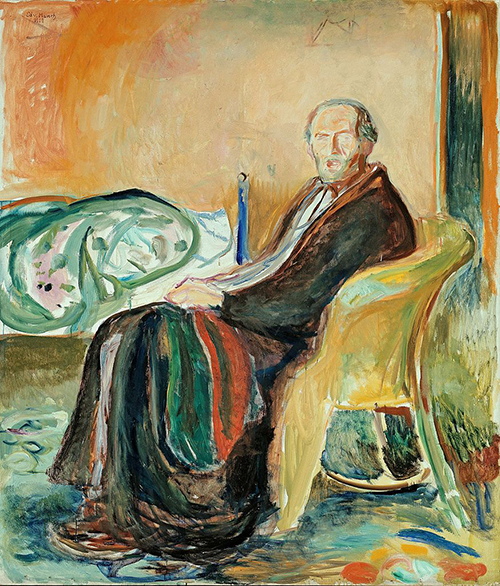
Self-Portrait with the Spanish Flu,1919-1920 by Edvard Munch. Oil on canvas (59 in x 51.5 in)
National Gallery of Norway. (Downloaded from Commons.wikipedia.org at 7pm EST on April 5 2020)
“My fear of life is necessary to me, as is my illness. Without anxiety and illness, I am a ship without a rudder. My art is grounded in reflections over being different from others. My sufferings are part of my self and my art. They are indistinguishable from me, and their destruction would destroy my art. I want to keep those sufferings” (Sue Prideaux, Edvard Munch: Behind the Scream. New Haven: Yale University Press, 2005, p. 251)
I contribute this reproduction of a painting, created by Edvard Munch sick with Spanish Flu, together with his quote, as an inspiration for artists and the rest of us during this time of the current pandemic. I find his courageous embrace of suffering, evident in this unflinching self-portrait while ill, to be deeply moving and encouraging.
We see here a solitary male figure, dressed in a dark red robe, holding a red-green kerchief on his lap, while sitting in a yellow armchair in front of the blue bed with crumpled green linen. His blank orange face, barely distinguishable from the background of the orange wall, confronts the viewer with the silent scream. Its palette recalls the colors of The Scream (1893) and the form of the face, here, resembles the gaunt face of the screaming figure. The turquoise, bluish floor contributes to the palpable feeling of disquiet and unease. The dark vertical rectangle of rough brush strokes (upper right), framed in red, suggests an open door and increases the anxiety of the viewer. The whole picture radiates a painful feeling of sickness and impending doom. The painting vehemently expresses Munch’s existential conviction that his suffering and his being are one
Sylvester Wojtkowski, PhD
New York, NY
sy.wojtkowski@gmail.com
Daily Image and Commentary #8, April 22, 2020

Lake Mungo 60, 2019 by Peter Cameron. Oil on linen
This image was painted at Lake Mungo, an ancient hub located in one of Australia’s flat desert areas. People have been weaving their lives into the very fabric of this environment for thousands of generations. The Lake last held water about 20,000 years ago yet remains a strong source of life and breath. Given breath we move together and apart, exploring centres and peripheries. And we hold. The birds know. With the wind, many old stories and songs can return to us, timelessly.
Peter Cameron
Sydney, Australia
peter@petercameron.com
Daily Image and Commentary #9, April 23, 2020
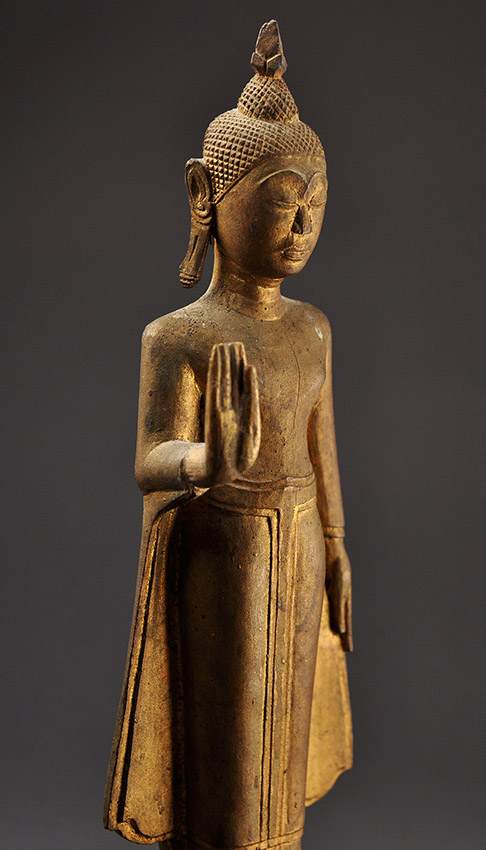
Antique Buddha statue with right hand in Abhaya-Mudrā, probably 18th-19th century, carved wood. Thailand / Lan Na
As I was on the eve of a huge change in my life, this image literally came to me. This Buddha was giving a form to something I could recognize. I discovered his right hand was in a position called Abhaya-Mudrā, the gesture of “fearlessness.” Mudrās are symbolic hand gestures. They operate like a seal. This mudrā embodies a sense of protection, peace, benevolence and the dispelling of fear. Sometimes when I feel afraid, I close my eyes, lift my right hand, and put it in this position so evident in the above image. My body and my mind calm down immediately. Sealed in a beyond-fear state.
Marie-Laure Humery
Paris, France
mlhumery@gmail.com
Daily Image and Commentary #10, April 24, 2020

One Plus One Does Dot Equal To Two, 2015 by Dao Pan. 120 x 120 cm. Artist’s possession.
With fears of death and loss at the forefront for all in this time, I present this artwork inspired by Xiaohe Cemetery, an archeological site in northwestern China. In this painting, a dog is facing what we may consider a symbolic representation of “in between” space reminding us of the living and the dead across 4,000 years—-connecting the spiritual and physical world, internal and external, Chinese, Asian and European cultures, desert and river landscapes.
To revere the nature
To respect the death
The ending of human life does not have to be death only—may be just of one physical form; possibly we return to the light in nature….
Mei-Fun Kuang
Copenhagen
contact@mei-psychology.com
Daily Image and Commentary #11, April 27, 2020
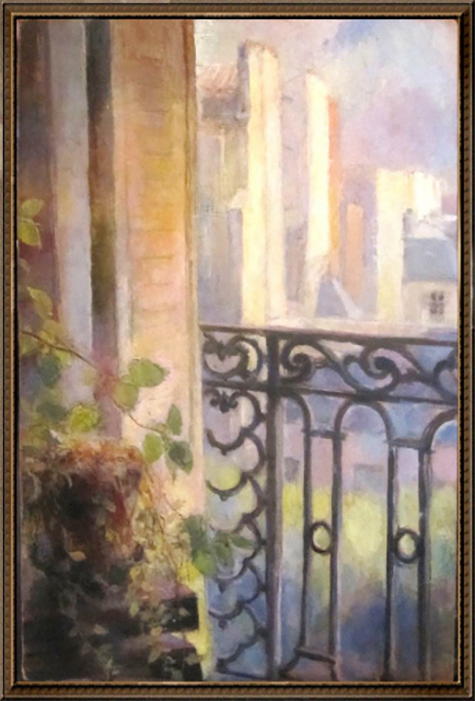
View from the window of Avenue de Breteuil, between 1940 and 1960 by Olga Székely-Kovács
Owned by Judith Dupont, Andilly, France https://www.olga-dormandi.com/
Olga Székely-Kovács was a Hungarian painter surrounded by psychoanalyst relatives: her mother was Vilma Kovács, her sister was Alice Bálint, and her daughter is Judith Dupont. She lived on Avenue de Breteuil in Paris between 1938 and 1960 after the forced emigration from Budapest. The picture was made there, depicting the view from inside – a small cut of the outside world. Nowadays, many of us have to stay in “a room with a view,” making journeys outwards and inwards in fantasy. It is frustrating but may provide the opportunity to notice new details from new angles, and to be able to creatively reflect on our situation as scholars, therapists, and/or artists—and really for all to use thoughtful reflective capacities and imagination.
Anna Borgos
Budapest, Hungary
borgosanna@gmail.com
Daily Image and Commentary #12, April 28, 2020
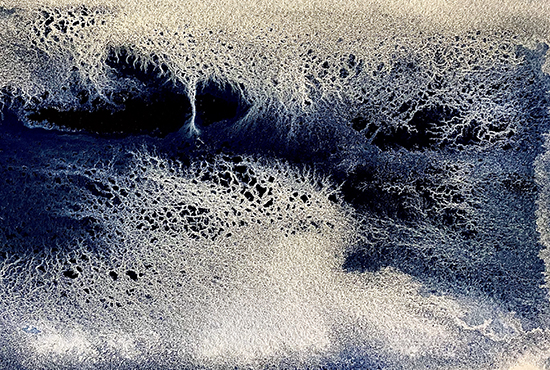
Jill Mellick, Web, March 10, 2020. Abstract, two pigments on paper. Possession of the artist.
Two pigments at a time on small paper are all I can use now; I have a fused neck and Stage IV cancer. Limits give birth to unprecedented interactions. Each pairing of pigments interacts uniquely. Miniscule changes in pigment-to-water ratio alter the whole; humidity changes interactions, second-by-second. I’ve sheltered in place since 2017; my body is immunosuppressed. As in life, so in my art: I must work with what I have; so, I work with the pigments. I cannot determine outcome. These two pigments in Web (image above) interpenetrate. Neither subsumes the other. Their unique interaction holds the tension of opposites for me: they are a microcosm of the tsunami power of the pandemic with its capricious volte-faces* as well as an homage to our fragile, indestructible, intricate interconnectedness regardless of circumstance.
*Volte-face (French): an act of turning around so as to face in the opposite direction; an abrupt and complete reversal of attitude, opinion, or position (Oxford).
Jill Mellick
Palo Alto, California
jill@jillmellick.com
Daily Image and Commentary #13, April 29, 2020

A fresco from Pompeii, circa 30 AD/CE. Photo by Marcus West, March 30, 2016
A fresco from Pompeii. Some things survive, endure, sustain; simple things, to share.
Marcus West
Findon Village, England
Daily Image and Commentary #14, April 30, 2020

Qi Baishi, The Spring of the Frog’s Sound Ten Miles, 1951. Ink on paper. Created by artist at age 91 to honor Chinese writer Lao She. Chinese Modern Literature Museum, Beijing.
This painting is from the famous Chinese painter Qi Baishi, The Spring of the Frog’s Sound Ten Miles, presents the scene of the spring water flowing down with small tadpoles within the rush and swimming towards the vast river.
The strange rocks at the source of the mountain spring seem to be dark and causing turbulence, but they have also helped spawn countless new life by creating pools for the tadpoles to grow.
The frog has a symbolic meaning of fertility, transformation and renewal in Chinese culture.
Rock paintings of frogs have survived since ancient times. According to a mythological archaeological study, the archetype of China’s ancestor and goddess Nuwa was a frog, and the name “Nuwa” is also pronounced the same as frog.
The frog is the mascot of our Chinese agricultural society. The folk proverb says: “The sky moves, the frog sounds” which means that the frog’s tweet can call for abundant rain that makes the crops flourish. The frog, as an auspicious symbol, has circulated from ancient times to this day.
The number six, represented by the six tadpoles in this painting, has special significance for Chinese people and culture. There are six lines in each trigram of the I Ching, representing the six stages of the development of all things. At the same time, two groups of two are divided into three parts, representing the relationships between heaven, earth and humans, with emphasis on the human and the universe. The principle of life revolves around harmony with nature. Human beings violate the laws of nature and are punished. This is also a warning to humanity in this pandemic.
There are more meanings that cannot be fully expressed in this short text inspired by Qi Baishi’s painting. I believe everyone who sees it will feel more…and in their own way…
Ainong Hu
Beijing, China
Daily Image and Commentary #15, May 1, 2020

Silenus with the child Dionysos. Marble, Roman copy of the middle 2nd century CE after a Greek original by Lysippos (ca. 300 BC) Museo Chiaramonti, Braccio Nuovo, Vatican Museums https://commons.wikimedia.org/wiki/File:Silenus_Braccio_Nuovo_Inv2292.jpg
Silenus had the gifts of extraordinary wisdom and the art of divination; represented here as an old man, with a thoughtful face while gently holding little Dionysus. What enchants and touches my deepest feeling is the loving exchange of gaze; these subtle facial expressions are so intense and powerful that they create a movement in the whole figure like a sweet cradling.
The caring for the divine child, for the other, brings us back to nature, ecology, to the scent of the earth that is reborn in spring. This extraordinary sculpture that has survived through time, represents the enduring strength of love and of spirituality that such intimate contact with the Senex can provide.
Livia Di Stefano
Catania, Italy
liviadist@gmail.com
Daily Image and Commentary #16, May 4, 2020
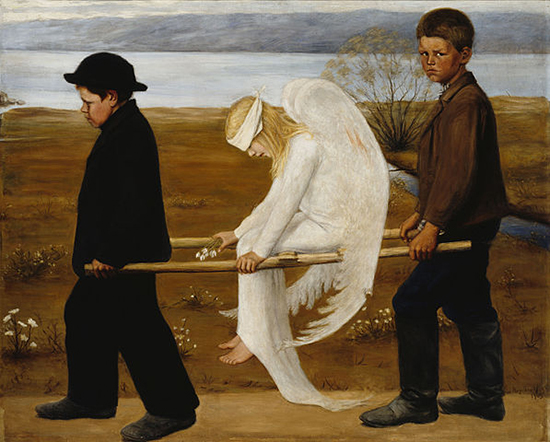
Hugo Simberg, The Wounded Angel, 1903. Oil, 127 cm x 154 cm. Ateneum, Helsinki, Finland
Two sullen boys carry a wounded angel on a stretcher. The angel’s wing has been wounded and the eyes are bandaged. The girl clutches a bunch of snowdrops, symbolic of healing, rebirth and the hope that comes with spring. This symbolist painting is full and rich with many layers of meaning.
The wounded angel hints at the rupture between the human and the divine; our failure to sufficiently listen to otherworldly realms has left us traumatized and immobilized. Yet these children, though grieving and feeling the pain of poverty themselves, show solidarity by aiding and carrying the injured figure. One of the boys looks at us, almost imploring that we, too, take seriously and consider well what they may be modeling through their relational connections with each other and with us, the viewers. Like Greta Thunberg, the boys in the painting take responsibility. There is a clear need for work to be done, during our current time, that requires nurturance and nursing care on all levels: personal, national and collective. Now, more than ever, we must listen to the invitation of angels who, as messengers, can help bring forth images from the depths of the unconscious.
Laner Cassar
Valletta, Malta (EU)
lanercassar@gmail.com
Daily Image and Commentary #17, May 5, 2020
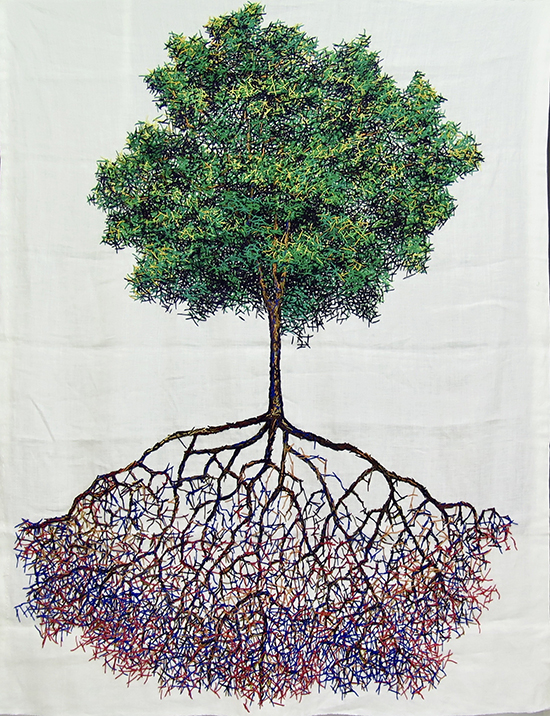
Cristiane Mohallem, Cambuci Tree, 2017; cotton thread on linen; 70 cm x 142 cm (70 in x 56 in). Private Collection of Guilherme Parente, São Paulo, Brazil, www.cristiane-mohallem.com
I chose this embroidery piece because I see the world tree in its image. The world being the cosmic tree, it goes on its way, regenerating itself, with the wisdom that comes from heaven above and earth below.
Cristiane Mohallem
São Paulo, Brazil
cfmohallem@gmail.com
Daily Image and Commentary #18, May 6, 2020
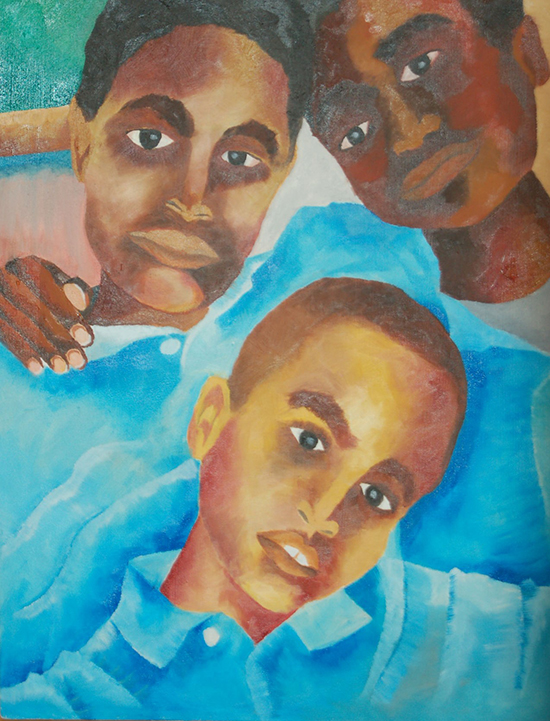
Kwame Scruggs, Tell Us Another Story, November 2012, possession of the artist
To contextualize this moving image, the editors feel that it will help our viewers to know a bit about Kwame and his very meaningful/inspiring work and projects. He is the founder and director of Alchemy, a non-profit organization in Akron, Ohio established in 2003. Alchemy uses mythological stories to engage urban adolescent males. In 2012 Alchemy was one of 12 programs to receive the National Arts and Humanities Youth Program Award by the President’s Committee on the Arts and the Humanities—the nation’s highest honor for after-school and out-of-school programs. Alchemy was also the backdrop for the award-winning, feature-length documentary, Finding the Gold Within (2017).
Kwame’s commentary about the painting above:
The three youths in this painting are pondering a question steeped in myth that we ask within our sacred circle, a temenos, that is created to hold a group of young men and is supported by elders also present. Each member understands that his answer will lead him in one direction or another, and that by listening to the responses of others, they may make a better decision themselves. At last within the container of a safe environment, they can open for the telling, discussion, and analysis of mythological stories: these young men can explore, discover and eventually incorporate positive character traits of the storied heroes into their own lives: they find the inspiration needed to embody, live-out and become the heroes of their own lives.
Kwame Scruggs
Akron, OH
myth@alchemyinc.net
Daily Image and Commentary #19, May 7, 2020
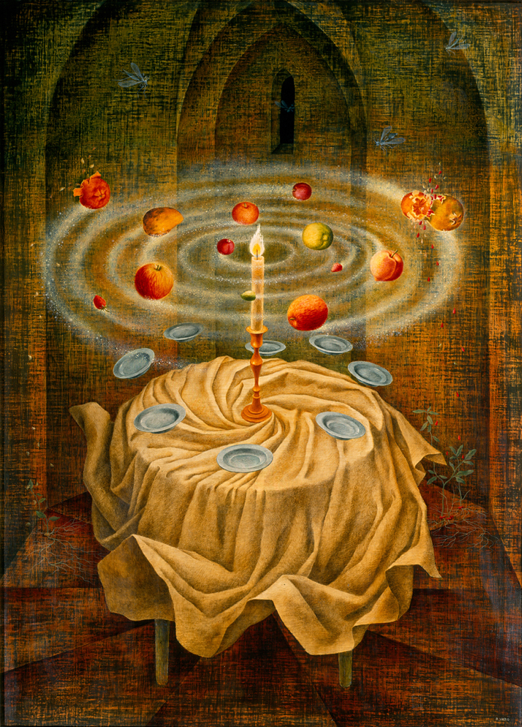
Remedios Varo, Naturaleza Muerta Resucitando (Still Life Reviving) 1963. Oil on canvas, 110 cm x 80 cm, Valencia, Spain.
This extraordinary spiral is Remedios Varo’s last painting—completed shortly before her sudden death at age fifty-five—is one of her very few paintings in which no human figure is present. We see the microcosm reflecting the macrocosm as the tangible world —the fruits of nature form the planets themselves—as the eight plates (a number of completion and infinity) move in the direction of the world beyond consciousness. The dragon flies we see are the “butterflies of night,” reminiscent of the soul’s transformation.
We feel the energy in this; Varo’s depiction of the myth of the Eternal Return. As the fruits become planets, the individual life is swept up into the All—a life lived in harmony with the music of the spheres—as this great whirlwind scatters the seeds that already sprout anew.
Remedios Varo’s life was one of repeated loss, deprivation and exile. She was unable to return to her Spanish homeland when Franco came to power; then she was forced to flee Paris when the Nazis invaded France. Varo had the good fortune, after a harrowing year on the run, to sail from Marseilles with some other artists, on a ship bound for Mexico. Here, in this country of sun, vibrant color and people of great warmth, she spent the rest of her life and created her most important works.
Mary Wells Barron
St. Louis, Missouri
marywells.barron@gmail.com
Daily Image and Commentary #20, May 8, 2020

Ketut Tagen, Un-named painting, 1986. Acrylic on canvas, 12 in x 17 in, Bali, Indonesia
“It takes wit and wisdom to make our way while our way is making us,
with no consolation but ART and the summer lightening of personal happiness.”
Tom Stoppard: The Coast of Utopia (2002)
This is a painting by an artist of the Penestanan Young Artists Group in Ubud, Bali. It hangs in my kitchen in New York City. It is of Balinese workers in a rice field. There are no faces portrayed in any of the artist Tagen’s paintings. His trademark makes it possible to project any emotion the viewer is feeling on to them: sad, happy, tired, disgusted, joyful, grateful. It reminds me of all the workers and farmers in the world who are still in the fields providing food for this desperate time we are living in. I am grateful for all those people and for art that also helps us to survive.
Susanne Short
New York, NY
sshortnyc@gmail.com
Daily Image and Commentary #21, May 11, 2020
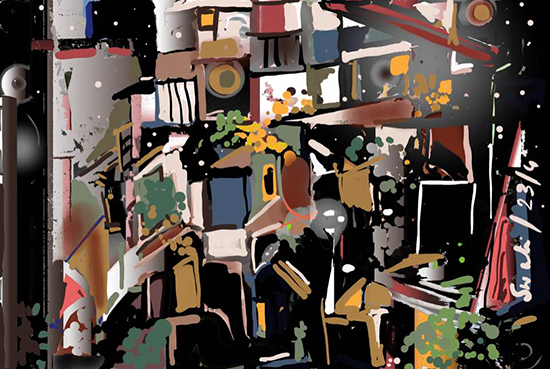
Swati Ganguly, Darkness Descends, 4/23/2020, digital, Santiniketan, India
Darkness Descends by Swati Ganguly is about a world hanging between despair and hope with disarrayed boxes piled over one another against a starry night sky. It is an artist’s impression of a despondent world, both infinite and finite, looking ahead at a time when healing and renewal will set in. The images loom out from the insides of Swati’s own home, Nepathya (Bengali, meaning “hidden”), in the beautiful university town of Santiniketan, where Nobel laureate Rabindranath Tagore* founded the world university, Visva-Bharati in 1921.
It is my alma mater, where Swati lives now and teaches literature. The insides of Swati’s beautifully tiered home give way to an alfresco terrace where a boxed wall and a starry sky clamor for space, (“boxes closing in”, Swati says)—-a reflection of the collective gloom that has descended on us in this global crisis. The play of light and shade, a lopsided wall and an infinite night sky, captured so deftly by Swati, is a gift from the depths, a melancholy that is paradoxically and simultaneously lined with hope about the birthing of a new world.
This is a collaborative contribution as Swati asked me to describe her painting in words and she is happy with what is written here. This painting was created on an Ipad and is the first digital image in this series.
*Rabindranath Tagore was awarded the Nobel prize (1913) for his book of poetry, Gitanjali (in English). Tagore wrote prolifically in all styles, composed music, painted, and built Visva-Bharati along the lines of India’s ancient schools of wisdom. Travelling worldwide, he met many world figures, including Sigmund Freud and Albert Einstein, and initiated inter-cultural dialogues on knowledge and culture.
Sulagna Sengupta
Bangalore, India
sulagna.sengupta@essex.ac.uk
Swati Ganguly
Santiniketan, India
ganguly.swati@gmail.com
Daily Image and Commentary #22, May 12, 2020
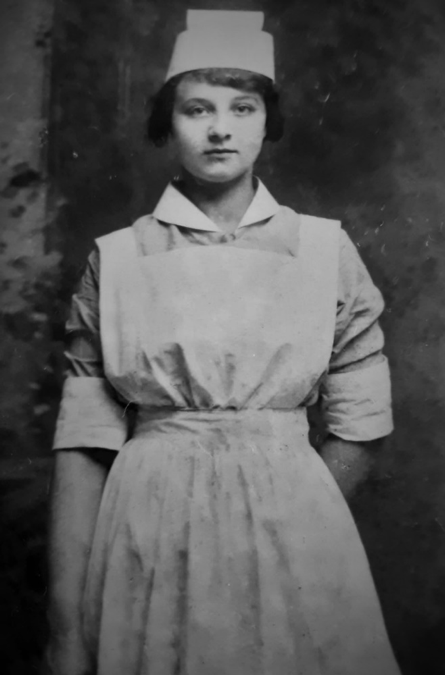
Anna Marie Muench Mick, 1918-1919
Special Edition
Art in a Time of Global Crisis: Interconnection and Companionship Project
In Celebration of Nurses and Caregivers Worldwide
Tuesday, May 12th is the 200th Anniversary of Florence Nightingale’s Birthday
We hope to honor nurses and all frontline caregivers who face into the shadows of suffering by offering an image representing the “Archetypal Nurse.” Our format is longer than usual today as we feel the timing is right to express our abiding gratitude to all who tend the sick with hope for health ahead.
Today, May 12th is Florence Nightingale’s birthday. Please take a moment to celebrate and offer thanks to nurses worldwide and to all healthcare givers and first responders who risk their lives daily to help provide for the well-being of all—especially at this extraordinary moment. Just as Florence, “the lady with the lamp,” led the way revolutionizing nursing and hospital practice, nurses have been dedicated to passing on the light of hope and compassion from the beginning of time and in every geographical location and society.
Please consider sending along this daily posting to those who are committed to caring for others as a kind of heartfelt “thank you note” for their commitment and service and let them know that they can sign on for supportive images and messages each day that will arrive in their email inboxes by clicking here or through the aras.org website.
Perhaps, a nurse will finish a night shift and find the new daily image on her cell phone and experience at least a moment of solace and companionship with those of us who are sending our gratitude and appreciation. Help them hold the lamp and the light in these dark times. Viruses are contagious but so is good will—pass it on.
Synchronistically, well before the current pandemic situation, The World Health Organization declared 2020 to be the “The Year of the Nurse and Midwife” in celebration of the 200th birthday of Florence Nightingale (1820–1910). The American Nurses’ Association (ANA) has designated May 6-12 as Nurses Week and May as Nurses Month to affirm and honor all who dedicate their lives to advancing the healthcare and welfare of people in every nation.*
The photograph above is of my grandmother, Nanna Mick who graduated from the West Jersey Hospital School of Nursing, Camden, NJ., in 1919 and worked endless hours and shifts throughout the Spanish flu epidemic while her fiancé (Charles my grandfather) was serving in the US Navy during WW I. My mother Barbara Mick Carter graduated from the same school of nursing in 1945 while my father (S. Thomas Carter) was on duty in the Navy at the end of WW II. My sister-in-law Mary Mulroy Carter followed and graduated from West Jersey in 1978. All of these brave women were young and were required to take classes, participate in rotating shifts “on the floor,” and live in the hospital while students. I began working at West Jersey as a Nurses’ Aide when I was 16. I am grateful to them and to all of the caregivers at West Jersey who so generously taught me about bedside care those many years ago and grateful for the many nurses who have surrounded and influenced my life from the beginning.
From these early roots, I was inspired and supported to go on for a BSN from Georgetown and MSN from Yale and finally to certification as an analyst with the IAAP. The imaginative drive for this current project also emerged, in part, from the values and service orientation of personal history tapping into the fundaments of the nurse archetype as an expression of the wounded healer.
The Art and Psyche Working Group** is grateful for the willingness of ARAS to partner, collaborate and make manifest this project as an expression of interconnection and companionship through art during a time of world crisis.
Linda Carter
Carpinteria, CA
Lcarter20@earthlink.net
**Brief Description of the Two Organizations Collaborating to Produce
Art in a Time of Global Crisis: Interconnection and Companionship
Daily Image Outreach Project
Art & Psyche is an unincorporated organization whose mission is to encourage the articulation of the symbolic essence of art in its many forms. Through conferences, presentations and the publishing of papers, it provides cross-disciplinary educational experiences with a depth psychological understanding to both members of the psychotherapeutic community and those in the art world. Every aspect of the development and production of the conferences and publication of the papers and presentations is based on bottom-up models of emergence. Through creative interaction among cross-disciplinary presenters and participants, the conferences themselves become energized and exciting temporary communities or multi-layered, emergent systems.
For more details of the history of this organization that has produced four international conferences since 2008, see the Film and Culture Section, The Journal of Analytical Psychology, November 2018, and the website from our last conference held in Santa Barbara in 2019: https://retreat.pacifica.edu/the-illuminated-imagination/
The Archive for Research in Archetypal Symbolism (aras.org) is a pictorial and written archive of mythological, ritualistic, and symbolic images from all over the world from all epochs of human history. The collection probes the universality of archetypal themes and provides a testament to the deep and abiding connections that unite the disparate factions of the human family.
ARAS Connections is a quarterly online newsletter, free of charge. Click here to subscribe.
Further, ARAS offers a 2-week summer program for teens to engage in creating art inspired by symbolic images along with other events and programs for all ages. They produced the bestselling Book of Symbols (Taschen, 2010) along with other substantial and fascinating books. Again, visit the website to learn more about the many resources that ARAS provides at aras.org
Daily Image and Commentary #23, May 13, 2020
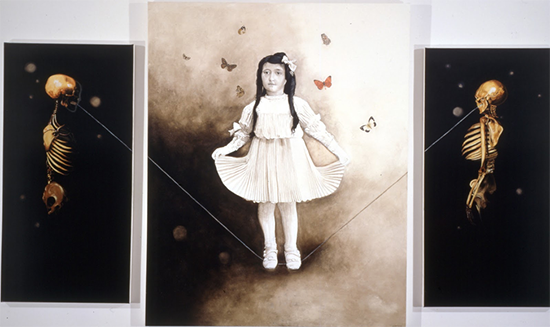
Marianna Gartner, “Tightrope Clara”, 1999; triptych, oil on canvas, 150 x 125 cm, 120 x 60 cm (x 2); private collection
Marianna Gartner is a Vancouver artist who finds inspiration from old photographs (mariannagartner.com). Her triptych shows a girl in a white dress, precariously balancing on a rope (as if before a circus audience) suspended from the mouths of two skeletal figures. The portrait quotes from two famous paintings: the skeleton to the left from “La Belle Rosine” by Anton Wiertz, admonishes his young subject about the vanitas of earthly pursuits; the skeleton to the right, from “The Anatomy Lesson” by Thomas de Keyser, is objectified by the medical gaze. From their separate canvases, these figures, outside her time and space, bear her aloft.
In our time, in these days of pandemic, Gartner’s Clara stands in all her butterfly-light resilience. Watching her, we feel our hopefulness and vertigo, our determination and fragility. We hold our breath, we reach out our arms in the impulse to catch (when so many are falling), we applaud her surviving (no mean feat). She quietly contradicts our collective dreams of safety and holds to a mysterious anxious potentiality in the now.
Craig E. Stephenson
New York City
craig@craigstephenson.com
Daily Image and Commentary #24, May 14, 2020

Ebstorf Mappa Mundi, 13th Century, Germany. Plassenburg ob Kulmbach. Landschaftsmuseum Obermain.
This map invites us into a view of reality that does not lie too far back in the history of Western culture: Small German market towns are connected to the tower of Babel, Venice and the dwellings of a variety of fantastical beasts. Used as a tool for navigating reality in the 13th century, it illustrates the blurry boundary between imagination and geographical facts (as we now know them) and with subjective and objective experience not clearly delineated. Created here is a web between everyday life and myth, between the market town and the heavenly Jerusalem.
A closer look reveals: the earth has a head, hands and feet. A Corpus Christi image is apparent as a living mystical body that is more than the sum of its constituent parts and keeps what is seemingly contradictory in meaningful connection with each other. I see the life of a divine whole here as it emerges in every patient’s Self in therapy.
Max Noak
London
silenceforbeginners@gmail.com
Daily Image and Commentary #25, May 15, 2020

The Betrothed*
…a female, whose aspect won the regards of every beholder, came out of one of the houses, and approached the cars. In her features was seen beauty, veiled and clouded, but not destroyed, by the mortal debility which seemed to oppress her… There was a tranquility and profundity in her grief, which absorbed all her powers… …she held in her arms a young girl about nine years of age, dead, but dressed with careful precision; her hair divided smoothly on her pale forehead, and clothed in a robe of the purest white. “Promise me not to touch a hair of her head, nor to let others do it, and bury her thus….Farewell! Cecilia! Rest in peace! To-night we will come to you, and then we shall be separated no more!” (From A. Manzoni, The Betrothed, first published in 1837. This book is considered to be one of the most widely read novels in the Italian language and is well known for its descriptions of the plague in Milan circa 1630.)
Francesco Bisagni
Milan, Italy
francesco.bisagni@gmail.com
Daily Image and Commentary #26, May 17, 2020

Daily Re-creation by Evangeline Rand. Both photos taken by Evangeline Rand. Site of no. 1, Fatephur Sikri, India, January 2013. Site of no. 2, Swamimalai, February 2018
Reflecting on something ordinary, something we think of as marginal, can open a whole world. It’s like finding an egg in a nest we had forgotten all about!
Every early morning In Tamil Nadu, South India, I wait to hear the broom sweeper and creator ritually opening the day. First, she sweeps away yesterday’s debris. Then she spreads a mixture of water and cow dung, an antiseptic, onto the brushed off surface, then sweeps again. Finally, free hand, she creates a beautiful kolam, a different one each day.
The kolam ritual of beauty, form and play, originally made with rice flour, is handed from woman to woman. It is an invitation for the goddess Lakshmi to find sanctuary. Even the ants are welcome! It makes visible the beauty of a relationship with the patterned earth. It catches our eyes as we walk across the home’s threshold, gradually dispersing that day’s kolam, knowing that tomorrow a new kolam will be created.
Evangeline Rand
Canada
drevangelinemrand@gmail.com
Daily Image and Commentary #27, May 19, 2020
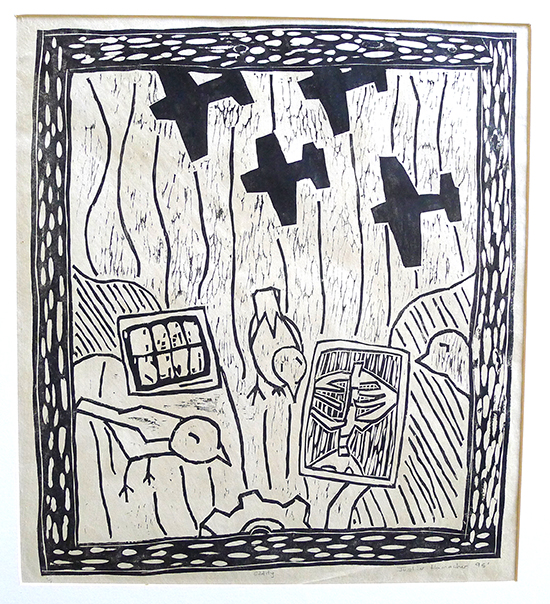
Oddity, Woodblock print,16in x 15in, 1995, Justin Hamacher, artist’s possession
Within, without, yours, mine, nature, humanity, air, breathe, observe, observed, flight, ground, machine inside, frail border, kind guides, animal friends, emulsions, growth.
Justin Hamacher
Seattle, United States
www.tellous.com
Daily Image and Commentary #28, May 20, 2020

Vyacheslav Lu-Ko, God is Sleeping, (2018), Kasteyev Museum, Almaty, Kazakhstan
On May 30, 2018, the Kasteyev Museum in Almaty, Kazakhstan, hosted a solo exhibition of contemporary Kazakhstan artist Vyacheslav Lu-Ko. His works are very bright, filled with interesting meaning and a kind of humor.
In this difficult time, I recall his work God is Sleeping (2018). Central on the canvas, imaged as sleeping and dreaming, is God. On both sides of the picture are balanced Cain on the left and Abel on the right, the first brothers who come with gifts to the sleeping God, but cannot reach him. Below, people cling to each other, like lost blind people holding smartphones in their hands. But God is not just sleeping, he continues to watch us through a magnifying glass. Is this not an allegory of what is happening at many levels and in many times?
This picture raises my mood, as it reminds me that we are not forgotten and that in fact it’s enough to break away from our smartphone and look at the sky. God is looking at us and waiting for us to look at him.
Igumnova Olga,
Almaty, Kazakhstan
igumnovaolga811@gmail.com
Translation
Russian
30 мая 2018 года в музее Кастеева г. Алматы, Казахстан, проходила персональная выставка современного казахстанского художника Вячеслава Люй-Ко. Его работы очень яркие, наполнены интересным смыслом и своеобразным юмором.
В это непростое время, мне вспоминается его работа «Бог спит» (2018 г.). На полотне спящий и видящий сны Бог, по обеим сторонам картины слева –Каин, а справа – Авель, которые пришли с дарами к спящему, но не могут до него дозвониться. А внизу люди, которые держась друг за друга бредут словно слепцы, держа в руках смартфоны.
Но Бог не просто спит, он продолжает наблюдать за нами через лупу. Чем не аллегория происходящего.
Эта картина поднимает мне настроение, так как она напоминает о том, что мы не забыты и на самом деле достаточно оторваться от своего смартфона, и посмотреть на небо. Бог смотрит на нас и ждет, когда и мы посмотрим на него.
Daily Image and Commentary #29, May 21, 2020

Sasint Tipchai, The Wise Elephant, 2015, Thailand. With artist permission*
There is a story of a boy-elephant who was trained to carry kids along the beach. One morning with a girl on his back, he sensed grave danger approaching and got very nervous, but he did not buck the girl off. The sturdy one ran to higher ground and withstood the impact of the fierce water rushing forward. The small elephant and the girl survived the 2004 Tsunami.
In a time of fear, good instincts can save one’s own life, but it takes so much more to save others. With a 60 million-year lineage, an elephant might know a thing or two about survival…together.
With permission from the artist, see his online gallery https://500px.com/sasintipchai
Arisa Pisitsotranon
Bangkok, Thailand
hellodeepfilm@gmail.com
Daily Image and Commentary #30, May 22, 2020
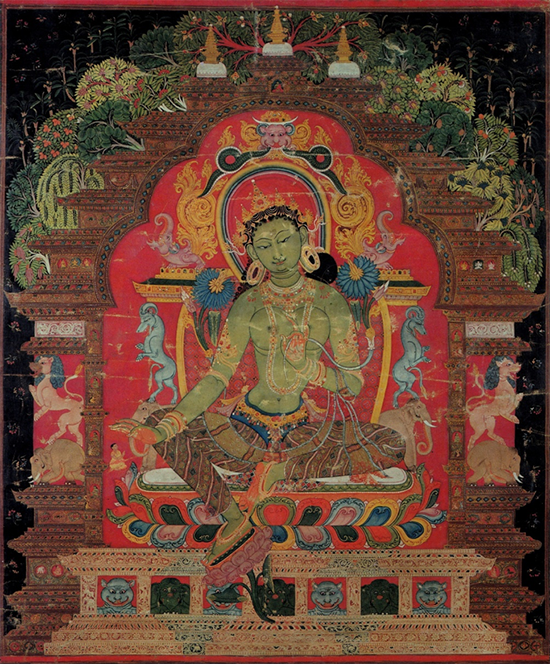
Green Tara, Place of creation, Tibet: Late 12th to 1st half of 13th century. The Cleveland Museum.
Green Tara has been an important presence in my life. She represents the wisdom of all the Buddhas and the wind element. She sits in a half lotus position ready to help us very quickly. She is known as the embodiment of the divine ACTION of all the Buddhas. She is therefore called “The Swift One.” She is also the “Liberator from all Misfortune,” and is known as the “Rescuer” from inner and outer fears, and interestingly for sickness and epidemics. Tara is a great resource in our psyche when feeling in need of immediate help.
Lucia Maneri
Worcester, MA
luciamaneri@msn.com
Daily Image and Commentary #31, May 25, 2020

Anna Ancher,* Sunlight in the Blue Room, 1891
In the blue room the little girl is sitting quietly crocheting under the kind gaze of the Madonna-like figure in the upper left corner. The main character in the painting is, however, the light itself that flows through the clear glass windows and is reflected in blue beauty on the wall. It is the blissful light behind and beyond that embraces the girl without disturbing her in her introverted activity.
In this picture I see solitude but not isolation. I see introversion full of life. What I see is an ability to be. To be protected, to be calm, to be contained.
This picture comforts me and gives me hope.
Misser Berg
Allerod, Denmark
misser.berg@mail.dk
*Anna Ancher (1859 – 1935) was a Danish painter from Skagen and is currently regarded as one of the most significant Danish impressionists. Most of her paintings shows the lives of women inside the house, either in quiet activity or just thoughtful and introverted with the attention directed to their inner world.
Daily Image and Commentary #32, May 26, 2020
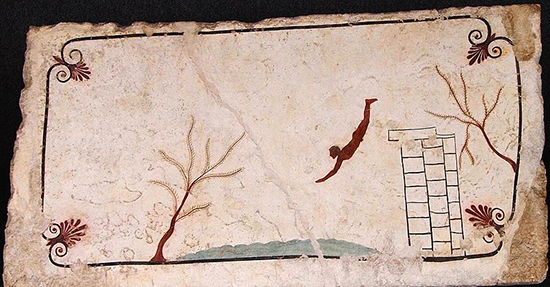
Tomba del Tuffatore (Tomb of the Diver), Underside of the top slab, fresco on limestone, 470 BC; 215 cm × 100cm, 7.1 ft × 3.3 ft. National Archeological Museum of Paestum, Italy
The dramatic immediacy and freshness of this 2500-year-old painting, capturing the moment when the diver is about to plunge into the unknown, grabs me each time I come back to it. One of the few, Etruscan inspired, Greek paintings of that period to depict a human figure, it is the lid of a limestone grave whose side walls are covered with frescoes depicting a symposium. Defined as “a social gathering at which there is free interchange of ideas,” a symposium seems to capture the spirit of coming together virtually at this particular moment, sharing images that are meaningful to us.
Matthias Leutrum
New York
matthias.leutrum@gmail.com
Daily Image and Commentary #33, May 27, 2020

Dimitra Natskouli-Ieri Pnoi, The Angel of the Fifth Realization: Metamorphosis, 2019. Pigments on canvas, Athens, Greece
The Earth is fully surrounded here by the electric blue and purple flames of transformation. The mythical phoenix, the bird that surrenders to the fire to be reborn from its ashes. The eye of the bird, the commonly known Egyptian eye of Horus, is nothing more than a sketch but symbolizes the seat of the soul. In-between the wings, the blue flames unfold the vision of the new earth: masculine and feminine energy, facing each other, in unity, in harmony, in fulfilment. My life, your life, each single life is present moving into this Metamorphosis!
Dimitra Natskouli
Athens, Greece
ieripnoi@gmail.com
Daily Image and Commentary #34, May 28, 2020
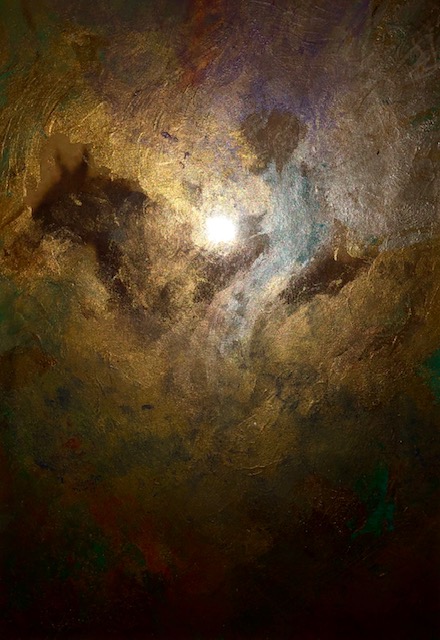
Juliet Rohde-Brown, Ancestor, 2019. Acrylic on paper. Artist Personal Collection, Carpinteria, CA
This painting was inspired by meditation, engaging the imaginal, and dialogue with ancestors. We see two sentient beings traveling in the dark wilderness. A small light guides the way. When I reflect on how many times our ancestors have experienced the kinds of losses and uncertainties that we face today, this is an image of inspiration. It speaks to facing the unknown, trusting the depths of the subtle world and the power of embodied life force, and honoring human and nonhuman relationships.
Juliet Rohde-Brown
Carpinteria, CA
jrohdebrown@pacifica.edu
Daily Image and Commentary #35, May 29, 2020
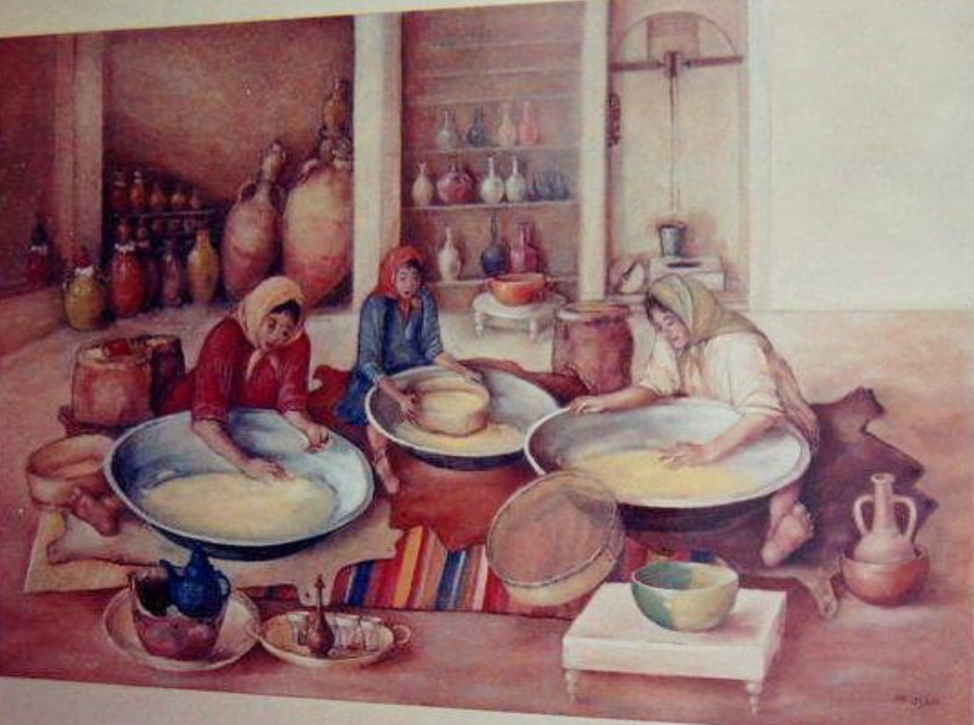
Mohamed Karray, Nos Racines et Notre Tradition (Our Roots and Our Tradition), 2005, Sfax,Tunisia
The work is named Nosracines et Notre Tradition, it was realized 15 years ago by Mohamed Karray. The location of what the author calls the “great scene” is his hometown Sfax (a city in the South of Tunisia).
I find this work appealing because of its double meaning, which is simple and deep at the same time: a scene of couscous handcrafting. However, a strong message emerges from this scene; a message of love, mutual help, solidarity and thought about difficult days. Such a message is expressed by a wonderful harmony of colours and lights.
As I am staying home at this pandemic time, the canvas has retriggered in me the nostalgia of being in a group and being physically close to people I love.
In our tradition of preparing “Oula”: we gather once a year to handcraft couscous, and we save those couscous reserves for the upcoming 12 months. On that day, we invite our cousins and neighbours who help each other in this tiring and enjoyable work.
Consequently, a great lesson emerges from this work, which is the usefulness of keeping (saving) some reserves.
The great quantities of couscous, which I initially did not know their utility turned out to be fundamental. It is related to security and to the others. It is designed and realized by women, who guarantee the continuity of food in all its forms.
Monia Benfredj
Tunis, Tunisia
bfmonia@yahoo.fr
Daily Image and Commentary #36, June 1, 2020

Mathew Bernstein (photographer, father), The Sanctity and Wonder of Life, (Isaac with mother Hannah Bloom), April 9, 2020
This is Isaac, my three-year old grandson. In one sense there is nothing symbolic here about Isaac and his interconnection and companionship with the sanctity of life, its depths and holiness. He reminds me of what I sometimes forget and have been separated from individually and collectively in our narcissistic busyness with mind/body splits. He IS interconnectedness and companionship and a reminder of the source from whence we have come and still have roots. The trick is to remember through body/feeling/being. No words.
Jerome S. Bernstein
Santa Fe, NM, USA
bernsteinjerome@gmail.com
Daily Image and Commentary #37, June 2, 2020

Cedrus Monte, Presence Called Forth, March 22, 2020. Photographer, private collection
By inviting the natural world more intimately into my life, recognizing the deep wisdom it holds, Mystery shows itself. I see what I do not see when I simply “use” nature—for just personal recreation.
Recently, during my daily walks in the forest, I have felt compelled to recognize the aliveness of many of the forest beings by taking their pictures. But only of the ones who have asked. I think the urgency of their request came from the desire to make their deepest presence known, to reveal the Invisible. To show their true identity. And their rightful place on earth.
Cedrus Monte
Zurich, Switzerland
info@culturenow.net
Daily Image and Commentary #38, June 3, 2020

Eric Clapton, Luciano Pavarotti, East London Gospel Choir – Holy Mother (Live). Please click here to watch the video – https://youtu.be/x9uYu4R2nk8
For All Who Have Suffered the Loss of a Child. You are Not Alone.
With gratitude to SS from the Editors.
Daily Image and Commentary #39, June 4, 2020

Deborah O’Grady, From the series Viriditas, 2018. Collection of the artist.
In times of great stress and anxiety, I find myself turning to the vibrant green, the viriditas or green energy as illuminated by Hildegard of Bingen*. Here, a scene of abundant nature and a gentle collaboration with an unknown human. The moss-covered barrel, collecting water in a cool creek, allowing the excess moisture to continue on its path to the ocean, exemplifies for me nature’s power of resurgence and the possibility of healing even the deepest of wounds. This forest, once burned, shows us the way. The human intervention is accepted. Viriditas soothes the soul. Recovery is possible.
*Hildegard von Bingen, Medieval German Abbess, composer, poet, herbalist and healer.
Deborah O’Grady
Berkeley, CA
debogrady@mac.com
Daily Image and Commentary #40, June 5, 2020

Margaret Tsirantonakis, Joy, 2020. Oil on canvas. Artist’s possession.
I created this painting soon after my mother passed away and when the COVID-19 virus was just beginning in the United States. I used some new oil paint colors that inspired the color combinations. The flowers were a symbol of the beauty my mom loved and that we shared. Although I was in mourning, I wanted to convey joy in color. As the current crisis has taken hold of our daily lives, having made this painting has been important to me. A positive reminder of the power of art as expression of love.
Margaret Tsirantonakis
Stamford, Connecticut, USA
mtsiran@hubar.com
Daily Image and Commentary #41, June 8, 2020

Chester Arnold, Thy Kingdom Come II, 1999, oil/linen, di Rosa Museum, Napa, California
Sometimes I find it helpful to meditate on an image that speaks to the personal or collective situation in which I find myself. Chester Arnold’s Thy Kingdom Come has served such a purpose for me many times in the last several years. The associations and emotions that come to me when I look at this image are manifold. One involves the medical term for a very strange tumor—a teratoma. A teratoma originates in stem cells going haywire and the tumor is made up of teeth, nails, hair, muscle and bone—all randomly thrown together in a confusing mass (massa confusa) of highly differentiated tissue. In times like our current pandemic, economic freefall, global social injustice and racial violence, I feel like we are witnessing a teratoma of distressed parts of the body politic rolling over us with the uncontrolled momentum of a teratoma running wild. The image also reminds me of The Myth of Sisyphus in which individuals and societies worldwide are in positions similar to that of Sisyphus, being run over by destructive forces that we keep having to push up the hill, only to be rolled over by them again and again. And, finally I am reminded of Jung’s passage from Wotan in which he says:
“Thus the life of nations rolls on unchecked, without guidance, unconscious of where it is going, like a rock crashing down the side of a hill, until it is stopped by an obstacle stronger than itself. Political events move from one impasse to the next, like a torrent caught in gullies, creeks and marshes…” (CW 10, para. 395)
Thomas Singer
Mill Valley, California
Daily Image and Commentary #42, June 9, 2020
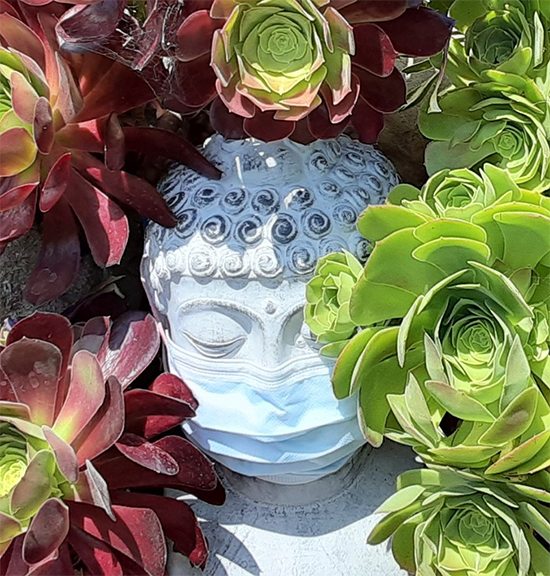
Lynne Adams, Covid Compassion, May 29, 2020
Lynne Adams
Carpinteria, CA
lynneloops@gmail.com
Daily Image and Commentary #43, June 10, 2020

Harmar Brereton, photographer, Statue of Odysseus, October 2018. Sculpture circa first century BCE, artist unknown, Athens Greece*
Homer’s portrayal of Odysseus, throughout the epic journeys, emphasizes the hero’s capacity to examine both sides before making a decision with sophrosyne (Greek having to do with clear headed, well-balanced, prudent consideration) as well as the hero’s great courage. We are reminded, here, of Odysseus’ response to Circe when she outlined the suffering and difficulties still facing him on return home. His response: “Bring the trial on!” (Trans. Robert Fagles)
*This statue was retrieved after a wreck was discovered in 1900 by Captain Dimitrios Kondos and sponge divers off the island of Antikythera in the Mediterranean.
I, myself, discovered it when conservators were in the process of repairing this extraordinary artifact in the museum basement and I persuaded the guards to allow me to photograph the image presented here. The profound nature of the mythological story, as well as the ability of this particular piece of artwork to withstand time, corrosion and hiddenness in the depths, provide evidence that the symbolic value has persisted against the odds and continues to carry meaning and the import of “homecoming” from the ancient past into the present.
Harmar Brereton
New York, NY
hdbrereton@aol.com
Daily Image and Commentary #44, June 11, 2020
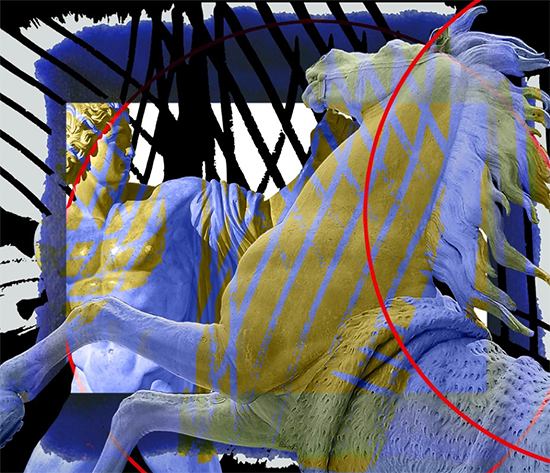
Antonio Mazzetti, Palafreniere (Groom), March 30th, 2020. Electro-collage, watercolor, and ink jet on cotton paper,110 cm x 95 cm. Archeological Museum, Copenhagen
This montage composition came into being when seeking inspiration for a new creation. I came across a photo I had taken of the Solvognen (Nordic for Sun Chariot, see below)* and it ignited a sense of a “something”: a beyond.
My artistic work process is that of reaching beyond, in an attempt to make visible what is not clearly tangible; in a way I do it for myself. Following the light from the Sun Chariot image, I sorted through other photos and selected ones that seemed to resonate with the “something” beyond words that I wanted to express imagistically.
The “groom” comes from a plaster cast from the marble original statue by Bertel Thorvaldsen (Thorvaldsen Museum) and I felt drawn to a photo of the “The Marly Horse” sculpture commissioned by Louis XIV, the Sun King, now at the Louvre. The light from the Solvognen picture lingered in the atmosphere influencing and leading the way: consequently, it seemed that the two sculptures from different times and places called out as if they belonged together within this light-filled context and came forward to meet my inner state.
I started to assemble the images using contemporary methods (see caption). It took time and attention to develop a composition as close to my feelings as possible. Then came the gold of the sun—light is important in all my work. The strength and beauty of the horse and that of the groom are in harmony; there seems to be a resonance in the muscles evident in each but also in the gaze that binds the two animals across species, deeply connected and sharing a profound respect. The man is both in service to the horse and simultaneously guiding and governing powerful instincts with firm but gentle attunement. However, memory of the Sun Chariot image shown through, enlivening my picture with golden light, brilliant but not dazzling. Though ungraspable and ephemeral, the light surrounds the substantial creatures and holds the emotional transcendent meaning—that of the beyond that I was seeking from within and reflected here through play (using materials and techniques across species) resulting in a representation that carries forward the original feeling and inspiration.
 *Source of inspiration
*Source of inspiration
(*Fonte d’ispirazione)
The gilded side of the Trundholm Sun Chariot (Danish: Solvognen)
Nordic, Bronze Age, National Museum of Denmark
(Italian Translation) Il lato dorato del Carro Solare di Trundholm (Solvognen in danese) Nordico, Età del Bronzo, Museo Nazionale di Danimarca
Antonio Mazzetti
Brescia, Italy
info@mazzettiantonio.it
Daily Image and Commentary #45, June 12, 2020

George Clausen (1852-1944), Girl at the Gate, 1920. Oil painting. Tate Collection. https://commons.wikimedia.org/wiki/File:Clausen,_Girl_at_the_gate.jpg / Public domain
Standing at the threshold of an open gate, what does this young woman’s gaze express for us in today’s world? What might she be imagining as she looks not at us, but beyond us to a place unknown or unknowable? We are invited to consider our experience of being and becoming and to imagine what may not yet be visible. I love this painting because she stands in a moment of stillness, waiting, contemplating something just beyond the confines of her yard. She is poised within the tension of opposites, an aspect of our current stay at home orders with the vicissitudes of grief, fear and uncertainties requiring that we reconcile the past and what we have lost with our longing and imagination for what might be possible but not yet visible.
Nora Swan-Foster
Boulder, Colorado, United States
nora@swanfoster.com
Daily Image and Commentary #46, June 15, 2020

Mary Eldridge, Torn, But Not Apart, June 1 2020, Ann Arbor Michigan
I’m in Ann Arbor, Michigan, often described as a “bubble” because of its remove from so many troubled areas in our state. But I’m from Detroit, and I’m deeply aware of racial injustices there, in Flint, and elsewhere in my state – and even here in the “bubble”. In the protests that began with the murder of George Floyd we’ve witnessed truth, justice, courage, love and community in old and ancient ways – prayer circles, the hospitality of food and water, the ringing of bells, singing, and new ways – car honking, phone flashlight shining, COVID mask wearing, and countless uses of technology that have shown us each other and communicated our needs, grief, anger, hope, beauty, tenderness, joy. In this time, we are torn, but not apart. We pray for breath, and that Black lives matter.
Mary Eldridge
Ann Arbor, MI
maryaeldridge@gmail.com
Daily Image and Commentary #47, June 16, 2020

Ginger Graziano, North Star, 2019, 18.5 in x 22.5 in, mixed media: pastel, gouache, and acrylic on watercolor paper, Asheville, NC
North Star was painted last year before the pandemic struck, prior to the current global turmoil and consequent struggles to locate a moral compass. At that time, I was thinking about the state of our Earth with climate disruption and the need for humanity to come together with some agreement about how to address the crises.
Above, the light of the moon has been eclipsed but within its circle shines the North Star, critical for navigation in earlier times by sailors and travelers to find their way in unknown territory. This dependable star, a point of orientation, represents hope and a direction to guide us through the darkness to find a safe harbor. The jumbled letters in the sky offer a message that we are trying to translate. Especially given recent events, the upward looking figures convey hope that we can continue searching for guidance and a language to express new unfolding realities.
Ginger Graziano
Asheville, NC
gingergraz@gmail.com
Daily Image and Commentary #48, June 17, 2020

Coming Full Circle: Completion of the Project, June 19, 2020
Development of this project was motivated by suffering as a result of COVID-19 as a service outreach through art, available to anyone around the globe feeling overwhelmed by fear and isolation. We hoped that the daily images and accruing virtual gallery might offer a moment of companionship. Several weeks ago, the world again convulsed dramatically and it has become clear that while the novel coronavirus is a very serious public health problem, so are other longstanding unaddressed issues such as systemic racism, economic hardship and lack of adequate healthcare for all. It seems that the peaceful worldwide demonstrations over these last weeks have been orchestrated by both top-down and bottom-up systems of emergence via social media. Consequently, we have come to realize that our original mission to provide companionship through art during a time of isolation and confinement was no longer as close a fit with the multiple complicated issues playing out rapidly; it has become clear that addressing these complex problems is beyond our scope through the current medium and daily image format.
We are grateful to all of those who sent in contributions and are sorry not to have been able to publish each one, but with many societies in turmoil and rapidly changing, submissions (from April) that were meaningful and in the queue for posting are no longer in keeping with the current situation; our system was/is not set up to meet the needs of lightning speed shifts across cultures. By Friday, June 19, 2020, the ARAS/Art and Psyche collaboration will have published 50 daily images and we feel that we have done our best to carefully curate and edit submissions from colleagues and friends representing various cultures, geographical locations, religious systems and life-styles.
Anyone interested can continue to visit the virtual gallery made up of these 50 daily images stretching from early April-June 19, 2020 (see aras.org). It was a project for a particular moment in history but the images and reflections may well continue to offer moments of meeting with art and soul. As with any museum or gallery, individual visitors will find a variety of possibilities, some that resonate with personal taste and with the state of one’s soul in a given moment, while others may not.
“Art in a Time of Global Crisis: Interconnection and Companionship” was an attempt to address suffering and isolation through art and word at a particular moment in history. We offer our thanks to those who sent in contributions and to all of the viewers who became part of our emergent community in the virtual domain of the internet. With opening again, came a necessary breaking out of social concerns that we hope will, at long last, be addressed on multiple levels.
With gratitude and abiding hope,
Linda Carter, Editor
Chair, Art and Psyche Working Group
Ami Ronnberg, Curator
ARAS and Art and Psyche Working Group Member
Art and Psyche Working Group Members:
Catherina Vezzoli, Billy Brennan, Justin Hamacher
The ARAS/Art and Psyche “Art in a Time of Global Crisis” was conceived in a moment of inspiration by Linda Carter who gathered together the Art and Psyche team including Caterina Vezzoli, Billy Brennan, and Justin Hamacher to join forces with ARAS’ Ami Ronnberg and Allison Tuzo. The ambitious goal was to bring people together from around the globe to connect through symbolic image and word at a time of worldwide suffering, isolation, fear and deep uncertainty. It was achieved in the remarkable, spontaneous creation of a virtual community. As virulent and dangerous as COVID-19 remains, the pandemic has moved more to the background of our attention as the complexity of economic and racial upheaval threaten further conflict and distress. No one can keep up with the 24/7 news cycle. This project’s 50 images did its job admirably for several months that were both short and long. The contributions will remain available on as a special ARAS gallery online and will serve as a continued source of inspiration. It is time to see what other creative offerings will help sustain us through the next many months that promise to be full of unexpected upheaval. In the meantime, we owe a deep debt of gratitude to the contributors of ARAS and Art and Psyche who made this effort possible.
Tom Singer
President of National ARAS
Daily Image and Commentary #49, June 18, 2020

The Last Egg, with an alternative title Epilogue, given by the artist Mary Borrie. Paint on plaster of Paris. Christine Downing, private collection.
I inherited this sculpture from my mother who called it The Last Egg. I only recently found out about the artist Marie Borrie who had titled it Epilogue. Both titles remind me of Gabriel Marcel’s beautiful essay, “The Phenomenology of Hope” in which he says that hope is not to be confused with optimism, hope is always hope against hope, hope is our response to despair. Hope is never just for myself; it is always for us, for the world that I am inextricably part of. Ultimately, hope is love. To which I would add this line from W.H. Auden, “How can we hope and not dream…” For me the sculpture perfectly balances despair and hope, the twinned feelings that the pandemic has brought forth. The woman is trying to protect the LAST egg, suggesting the ending of the world as we know it, which is also, of course, the last EGG as the possible birth of something new. For me it echoes the German expressionist artist Käthe Kollwitz’s powerful etchings and sculptures.
Christine Downing
Orcas Island, WA
cdowning1931@gmail.com
Daily Image and Commentary #50, June 19, 2020

Jon H. Davis, Equilibrium, Mandala, January 2020, Warwick, NY. Digital alchemy photograph. Possession of the artist
The time for healing is now. For me, Mother Nature is the great healer, with connective and transformative powers. I created this mandala, Equilibrium, with my process of digital alchemy from my photograph of one of the most ancient life forms: moss. Each time I look at this mandala–with hues of green, which are particularly healing–I discover signs of life and hope, looking back at me. I believe they are nature spirits, reminding and encouraging us to reconnect with the natural world in these difficult times, making order out of chaos, while restoring our equilibrium.
Jon H. Davis
Warwick, NY
jonhdavis@mac.com
Daily Image and Commentary #51, June 22, 2020

Mater 2 by Pia Imbar. Mixed media on canvas, 113 x 113 cm, 2011, artist’s possession
*Please see link below for an extraordinary experience related to this image
In these times, when anxiety, uncertainty, and insecurity are interspersed with hope and a profound questioning of our society’s values and ethics, I propose this painting by Pia Imbar (http://www.piaimbar.com/), which represents our pregnant Earth. To me, it is a powerful reminder of how important it is to take care of the world that we will eventually leave to our children, and it is my hope that the present crisis may also be pregnant with insights that may lead to solutions and decisions that are more respectful of life on this planet in all of its forms.
*To view “Piano and Painting,” a beautifully crafted 3 minute, stop motion video of Pia’s creating the stunning image above, accompanied by Catherine Schneider on piano, please visit https://youtu.be/fxu9xlz2evM
Ernst Falzeder
Salzburg, Austria
falzeder@gmail.com
Daily Image and Commentary #52, June 22, 2020
A Final Farewell…
Dear Daily Image Viewers,
We conclude the Art in a Time of Global Crisis: Interconnection and Companionship that began on April 13th (please see farewell announcement posted June 17th) with a reprise of Mater 2 with commentary by Ernst Falzeder including the short video of Pia’s creation process with beautiful piano accompaniment by Catherine Schneider.
We feel that this extraordinary contribution is one of profound hope for new life amidst a world in chaos. Following Jung’s use of alchemical metaphors, dissolution is an essential aspect of transformation to loosen structures that have become too rigid and inflexible, disallowing creative emergence leading into the future. Suffering through disruption opens the door for repair and previously unimagined, potential possibilities for reconfigurations and surprising new entities never known before. Mater 2, the commentary, film and music provide living symbols through multi-modal artistic expression. This holistic image conveys the intention of our project: to offer a sense of companionship and containment through universals common to all. (To be found by scrolling down following this message.)
The organizers are grateful to the published contributors, to those who generously sent submissions that we could not post and to all of you, our viewers, who participated in this virtual community. All of us working on the project feel a sense of sadness about this conclusion but are clear that given our rapidly changing world in turmoil, it was necessarily time-bound and after 50 postings, the moment to finish is now. We offer thanks to those of you who sent messages of appreciation as well as to those who offered challenge and critique. Given the rapidity and time pressures with which this project came into being and the limited human resources for management and production, it was not possible for us to invite and respond to public commentary.
The 50 daily images will continue as a completed body of work as the Interconnection and Companionship Virtual Gallery that you can continue to visit over time on the ARAS website. Perhaps some of these works and the gallery itself will become “old friends” with an ongoing and steady presence over time.
The Art and Psyche Working Group including Linda Carter (Carpinteria, CA), Caterina Vezzoli (Milan, Italy), Billy Brennan (Providence, RI) and Justin Hamacher (Seattle, WA) express our gratitude to Ami Ronnberg, (ARAS Curator), Allison Tuzo (ARAS, Associate Director), Tom Singer (ARAS, President) along with the ARAS Board for their willingness to take a risk with our initial idea and offer substantial resources and platform to manifest this worldwide outreach endeavor. Over the years, our groups have collaborated with ARAS offering support for four Art and Psyche conferences between 2008-2019 and many presentations coming out of these conferences have filled the “pages” of ARAS Connections, a wonderful fit as this format has allowed for multiple images, video and music not possible within traditional written text publications. The Art and Psyche Working Group now takes a bow with gratitude to ARAS, our organizational host and companion, in producing the daily image project.
There are many excellent offerings that were not posted as part of this project. We are considering posting these as a group within a second gallery where they can be viewed as further amplification of a specific historical period of global “sheltering in place” representing a “spirit of the times” as described by Jung in the Red Book. Should we decide to proceed, we will let you know.
With abiding hope and gratitude,
Linda Carter
Editor, Daily Image Project
Chair, Art and Psyche Working Group